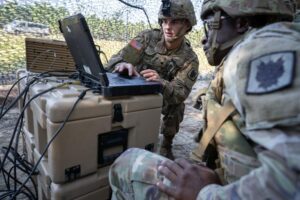The Army has detailed a new policy for improving software development practices, aiming to more rapidly upgrade and develop software capabilities it’s acknowledged as “the essential driver” across its capabilities and platforms.
The new policy, which has gone into effect immediately, will adjust how the service writes requirements for software capabilities and details the service’s embrace of more flexible acquisition approaches for software development efforts.

“We’re learning from current conflicts — including in Ukraine — that the Army’s success on future battlefields will depend on our ability to rapidly update software and disseminate it to the operational force,” Army Secretary Christine Wormuth said in a statement. “Software development must be a source of our military advantage and the Army’s new software policy will ensure we have the right processes in place to inject innovation quickly and achieve a digital transformation of our warfighting capabilities.”
The Army said the new policy “institutionalizes modern software development approaches across the Army, in line with industry best practices,” to include focusing on more iterative development and delivery of new capabilities.
“Our traditional approach to software is no longer meeting the demands of our warfighters,” Army Under Secretary Gabe Camarillo said in a statement. “Software development must be a source of our military advantage and the Army’s new software policy will ensure we have the right processes in place to inject innovation quickly and achieve a digital transformation of our warfighting capabilities.”
The Army adds the policy includes reforming traditional processes for the software development lifecycle to take on a more modern approach, noting prior efforts have “historically been cumbersome and time intensive.”
“This includes changing the way requirements for software systems are written, the types of acquisition strategies and buying models employed and how the Army writes its requests for proposals and contracts with vendors,” the Army said. “It also streamlines and modernizes the test and evaluation activities required, and changes how these solutions are assessed for cyber vulnerabilities. Lastly, it modifies the way cost estimates for agile software solutions are developed and how these systems are supported and maintained over time.”
For writing requirements, the Army said it will now look to capture software needs in “concise, high level needs statements in place of the detailed, prescriptive requirements documents used in the past.”
The Army’s push to employ more flexible acquisition and contracting strategies will involve maximizing use of the Software Acquisition Pathway, which is tailored for rapid and iterative delivery consistent with industry practices,” the service said.
The new policy also looks to “reduce the time and resources required to deliver software,” to include removing duplicative test requirements and cyber security processes, as well as adopting a new sustainment model that plans for continuous upgrades and development over the technology’s lifecycle.
“As best practices in software development continue to evolve, the Army will adapt its guidance, as appropriate,” the service said.